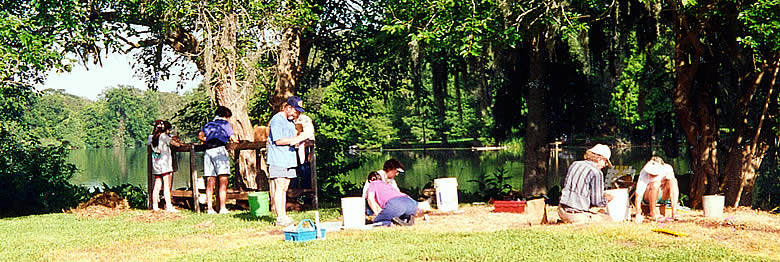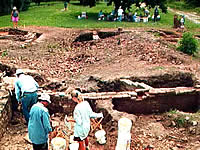
Beginning field school in 1994. Note
all the rubble in the center of the picture that will
be removed, brick by brick, over the next two years!
Click images to enlarge
|
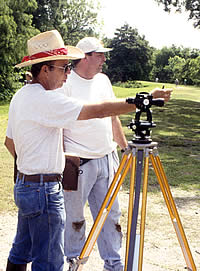
Mapping the site. Crewmembers get
ready to shoot in positions with the transit. (Photo
by Mott Davis.)
|
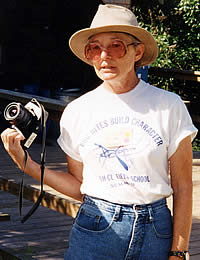
Bug Bites Build Character! Joan Few,
principal investigator at Lake Jackson Plantation, delivers
a morale-building message for workers in the tropical
clime. Photo by Sue Turner.
|
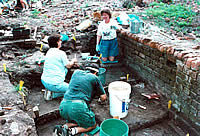
Excavating the area just west of
the front porch of the main house. This area served
as a dumping place for household trash and produced
many buttons, personal items, dish fragments and an
almost complete ceramic pitcher.
|

Amid apparent chaos, there's lots
of learning going on. Members of the kids program excavated
several important structures at the field schools. Photo
by Mott Davis.
|

TAS stalwarts. Pinky Roberts, ace
TAS T-shirt designer, and the late Francis Stickney,
check field notes. Photo by Sue Turner.
|
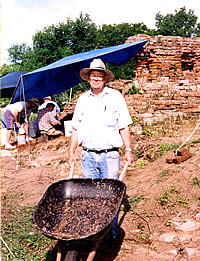
An empty wheelbarrow clearly brings
joy to Bob Turner. Photo by Sue Turner.
|
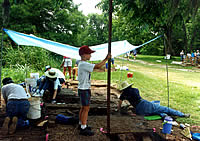
A young crewmember learns the art
of holding a stadia rod for a transit reading. Photo
by Mott Davis.
|
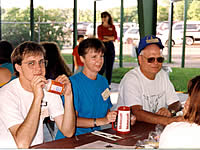
Brenda Whorton and Jim Blanton (right)
share a moment's respite at the dinner table after a
hard day's work. Photo by Sue Turner.
|
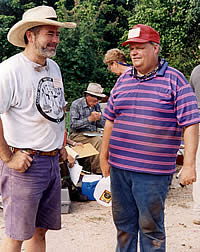
Former TAS president Skip Kennedy
(right) takes a breather to visit with a friend. Photo
by Sue Turner.
|
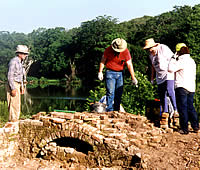
TAS members admire the handiwork
at the mill excavations. The late Jim Word, longtime
advocate of archeology in west Texas, is on left. State
archeologist and former TAS president Pat Mercado Allinger
is at far right. Photo by Sue Turner.
|
|
Conducting two TAS field schools at the Lake
Jackson State Archeological Landmark (LJSAL) required strategic
planning worthy of a military campaign, coordination between
a bevy of "stakeholders," and, of course, lots of
labor and luck. These efforts paid off in significant archeological
accomplishments, field education for beginners, and many good
times. Good fortune smiled on the project as well: the humidity
was low, the nights were surprisingly cool, and the mosquitoes
and alligators decided to clear out when the TAS moved in!
The 1994 and 1995 TAS field schools were conducted
at the Lake Jackson plantation and sugar mill complex as well
as at the nearby Follet Lake site. These field schools provided
the TAS membership with two types of archeological opportunities:
the chance to excavate the structural remains (i.e. brick
walls) of a Texas antebellum sugar/cotton plantation or to
work on a massive late prehistoric Rangia shell midden.
Along with archeological operations and training provided
to novices, there was the usual fun and antics among the crews.
The two "Clute sisters" (i.e. Andie
Comini and Brenda Whorten) made their zany debut at these
field schools. Wearing outlandish wigs and costumes, they
dropped into every work area at the field school bringing
smiles from weary, heat-exhausted workers. And who could forget
Andie Comini's motor home? It resembled a large Gateway computer
box on wheels with accompanying long horns and braying trumpet?
The Long Road to the Starting Line
Long before field school could set up and excavations
begin, however, there were months of preparations. Members
of the Brazosport Archeological Society (BAS) and Houston
Archeological Society (HAS) battled the elements and tropical
critters to prepare the site. In an environment rich in heat,
humidity, snakes, mosquitoes, and virulent poison ivy, these
hardy crews cleared away vegetation and huge expanses of brick
and rubble prior to the actual field school.
There were tactical hurdles as well: strings
of meetings, planning sessions, debates, reevaluating, compromising
and ultimately agreement among the major stakeholders of the
proposed field schools. Each had a role and significant interest
in the operations; each made a major contribution to the efforts.
In addition to the TAS field school committee and BAS and
HAS members, there were the Lake Jackson Historical Museum
(owner of the LJSAL); the City of Lake Jackson (owner of the
park where camping and programs were held); the Texas Historical
Commission (administrator of LJSAL's archeology); Brazosport
College (site of the 1994 archeological lab); and Brazosport
Museum of Natural Science (site of the 1995 archeological
lab and temporary repository for all the artifacts found at
the LJSAL and Follet Lake site.
Last but not least among interested parties
was the Dow Chemical Company (owner of the Follet Lake site,
provider of funds for both years' major speakers, and, perhaps
most importantly, the underwriter of each year's Porta-Potty
expenditure!)
These stakeholders were singly and as a group
presented with the most optimistic vision of what the two
TAS field schools would look like. Buy-in by all stakeholders
was essential if these field schools were to be successful.
And, as was demonstrated by each stakeholder, their ardent
support for the field schools went far beyond what was expected
of them.
Learning Opportunities Unlimited
Both field schools provided the participants
with opportunities to learn more about the two sites being
investigated through presentations and demonstrations. In
addition, prominent Texas ar-cheologists gave talks about
work they performed on other sites in the region. To add to
these learning experiences, a special presentation was given
each year. In 1994, Edwin C. Bearss, Chief Historian of the
National Park Service, Washington, D.C., discussed his work
in discover-ing and raising the sunken Union Ironclad, the
USS Cairo.
At the following year's field school, ceramics
expert George L. Miller led a workshop in historic ceramics.
Known for his nineteenth-century ceramic cost indexing (an
economic approach to interpreting ceramics from archeological
sites), Miller attracted a number of people who registered
for field school solely to be present at this workshop. Some
drove from as far away as New Mexico, the Texas Panhandle,
Oklahoma and Kansas to attend. Typically, his workshops are
given on the East Coast, are much smaller, and thus more difficult
to attend. The all-afternoon presentation was done "in
the round" and is still touted by Miller as his largest
ever workshop.
Kids and Divers Explore New Realms
Participants in the children's program maintained
a strong presence during both field schools. Younger children
worked on Building A, the storehouse. They exposed the double
brick floors of this building and opened several smaller units
adjacent to the building. These children also toured many
county historical sites and museums and, on two occasions,
somehow ended up at Surfside beach and the jetties. Older
children with years of field experience were integrated into
many of the adult crews. There were reservations at first
about doing this, but it turned out to be a successful change
in operations.
The work of the underwater archeology crews
(which came to be known as the TAS Navy) attracted attention
as well. Braving muck and a tangle of aquatic plants, Brenda
Whorton and assistants surveyed the bottom of the oxbow lake
to determine if it could have been smaller during the nineteenth
century and used a magnetometer to look for anomalies. Their
efforts paid off: they discovered the original road (now underwater)
leading from the sugar mill to the other side of the lake
where the slave quarters and other buildings were located.
Although the divers had been assured that there
were no alligators present, the critters apparently returned
soon after the TAS field school cleared out. The very day
after field school ended, Joan Few learned that a 5-foot alligator
was spotted in the lake!
To learn more about the Texas Archeological
Society and how to participate in the annual field school
held each June, visit their website at www.txarch.org/.
A little music is just the right note for relaxation at twilight.
Photo by Sue Turner.
TAS Open House at the end of Field School. Notice
all of the bricks stacked on the right that have been removed
one by one during excavations of the sugar mill.
|
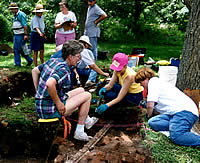
Crowding in the units is fine among
good-natured crew members. Photo by Mott Davis.
|
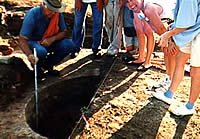
Andie Comini shows her delight in
finding lime at the bottom of the well being measured
by Johnny Pollan.
|
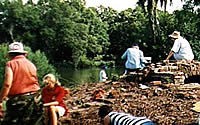
Sugar mill workers. Crew chief Brownie
Roberts (in orange shirt) directs operations in the
mill area. Note the curved opening of the flue chimney
on the right.
|

Sign of the times during project
planning? Photo by Sue Turner.
|
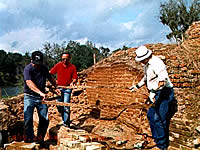
Dick Gregg, Houston Archeological
Society, on the right along with Gary Vickers of the
Brazosport Archeological Society in the red shirt,
and an unidentified volunteer, remove a band from the
treadmill excavated in the sugar mill.
|
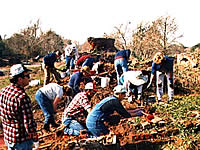
Members of the Brazosport Archeological
Society and the Houston Archeological Society carefully
removing bricks and rubble from the ruins of the sugar
mill.
|
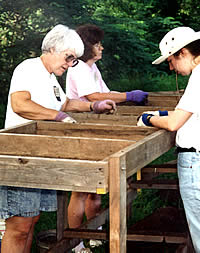
Crew members enjoy the pleasures
of sifting dirt through the screens. Photo by Sue Turner.
|
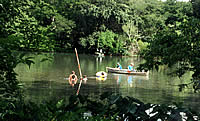
Nautical archeology. A survey and
mapping expedition to the bottom of Lake Jackson was
led by diver/archeologist Cathy Hoyt.
|
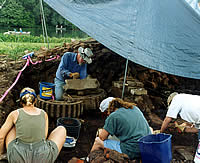
Getting into gear. Crew members toil
under a tent, unearthing heavy iron machinery parts
from the mill while others play, er…, do survey
on the lake. Photo by Mott Davis.
|
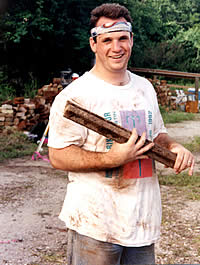
A little dirt, some heavy metal….
It just doesn't get much better. Photo by Sue Turner.
|

TAS members pitched their tents in
a park-like setting during field school. Photo by Mott
Davis.
|
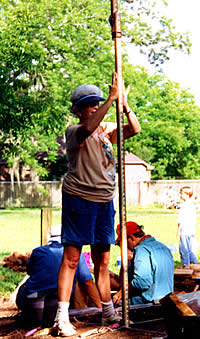
Rock art specialist Teddy Stickney
shows her rock-steady skills with the stadia rod. Photo
by Sue Turner.
|
|
